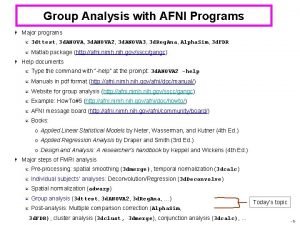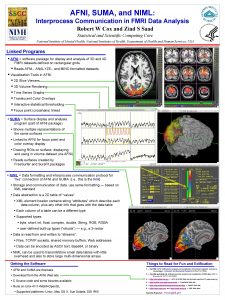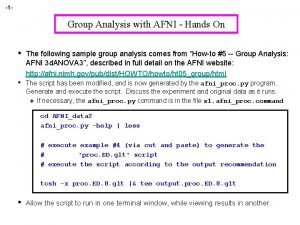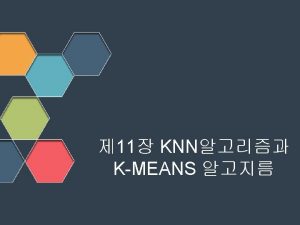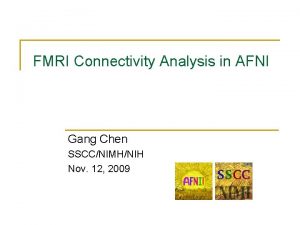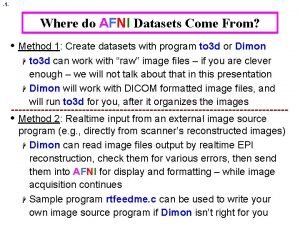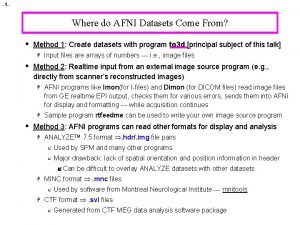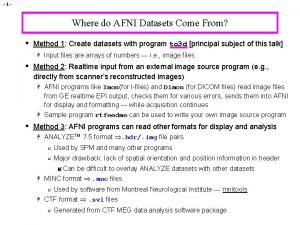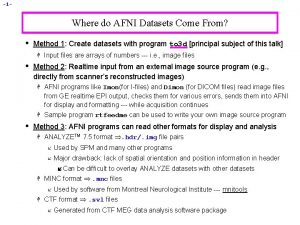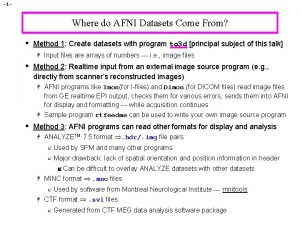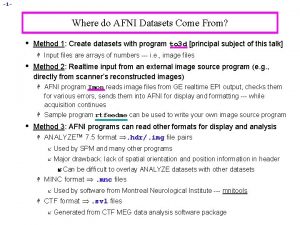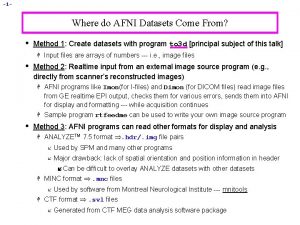1 Where do AFNI Datasets Come From Method




![-5 - Example 2 – run_Dimon. csh uniq_images I*[0123456789] > uniq_image_list. txt Dimon -infile_list -5 - Example 2 – run_Dimon. csh uniq_images I*[0123456789] > uniq_image_list. txt Dimon -infile_list](https://slidetodoc.com/presentation_image_h2/a2a24f10aaa3e9c300a5f3905f1884a9/image-5.jpg)
![-6 - Example 2 – run_Dimon. csh – Unique Images uniq_images I*[0123456789] > uniq_image_list. -6 - Example 2 – run_Dimon. csh – Unique Images uniq_images I*[0123456789] > uniq_image_list.](https://slidetodoc.com/presentation_image_h2/a2a24f10aaa3e9c300a5f3905f1884a9/image-6.jpg)
![-7 - Example 2 – run_Dimon. csh – Sorting Input Files uniq_images I*[0123456789] > -7 - Example 2 – run_Dimon. csh – Sorting Input Files uniq_images I*[0123456789] >](https://slidetodoc.com/presentation_image_h2/a2a24f10aaa3e9c300a5f3905f1884a9/image-7.jpg)
![-8 - Example 2 – run_Dimon. csh – Other Details uniq_images I*[0123456789] > uniq_image_list. -8 - Example 2 – run_Dimon. csh – Other Details uniq_images I*[0123456789] > uniq_image_list.](https://slidetodoc.com/presentation_image_h2/a2a24f10aaa3e9c300a5f3905f1884a9/image-8.jpg)




- Slides: 12

-1 - Where do AFNI Datasets Come From? • Method 1: Create datasets with program to 3 d or Dimon H H to 3 d can work with “raw” image files – if you are clever enough – we will not talk about that in this presentation Dimon will work with DICOM formatted image files, and will run to 3 d for you, after it organizes the images • Method 2: Realtime input from an external image source program (e. g. , directly from scanner’s reconstructed images) H Dimon can read image files output by realtime EPI reconstruction, check them for various errors, then send them into AFNI for display and formatting – while image acquisition continues H Sample program rtfeedme. c can be used to write your own image source program if Dimon isn’t right for you

-2 - Creating AFNI Datasets with Program Dimon • Dimon reads DICOM image files and assembles them into AFNI datasets (using program to 3 d) H Can also read GEMS 5. x I-files; plus Ni. FTI and AFNI datasets if needed • The collection of all 2 D slice data forms the. BRIK file H An AFNI dataset can contain a single slice • Dimon has many different ways of being run, to deal with different situations that come up in the input files • But we will only have 2 simple examples (next slides) • Program dicom_hdr is used to write out a formatted table of the header information from a DICOM file H This information can help when there are problems å Sample output near end of presentation

-3 - Example 1 – EPI Time Series • Switch to the directory with the sample data: H cd ~/AFNI_data 6/EPI_run 1 • Run this command H Dimon -infile_prefix 8 HR -gert_create_dataset • The Dimon program does these things: • • • Scan the input files (all files with names starting with 8 HR), determines where each 3 D volume ends (one TR) Runs to 3 d to assemble all the input files into one AFNI dataset, with 68 3 D volumes, each one with 34 slices Saves the dataset with a default prefix name Out. Brick_run_003+orig • You can choose the output prefix yourself – see next example

-4 - Example 2 – T 1 -Weighted Anatomical Volume • Switch to the directory with the sample data: H cd ~/AFNI_data 6/DICOM_T 1 • Run this command (almost the same as Example 1) H Dimon -infile_prefix I -gert_create_dataset • The Dimon program fails! • • The reason: the filenames (I 1000000, I 1000001, …) are not in the correct order to make up a 3 D volume To see this disorder (chaos ), run command aiv I* and scroll through the slices (aiv = AFNI Image Viewer) • To fix this problem, the run_Dimon. csh script was written • To run this script, type tcsh run_Dimon. csh • See next slide for script
![5 Example 2 runDimon csh uniqimages I0123456789 uniqimagelist txt Dimon infilelist -5 - Example 2 – run_Dimon. csh uniq_images I*[0123456789] > uniq_image_list. txt Dimon -infile_list](https://slidetodoc.com/presentation_image_h2/a2a24f10aaa3e9c300a5f3905f1884a9/image-5.jpg)
-5 - Example 2 – run_Dimon. csh uniq_images I*[0123456789] > uniq_image_list. txt Dimon -infile_list uniq_image_list. txt -gert_create_dataset -gert_write_as_nifti -gert_to 3 d_prefix T 1. 3 D -gert_outdir. . -dicom_org -use_last_elem -save_details Dimon. details -gert_quit_on_err
![6 Example 2 runDimon csh Unique Images uniqimages I0123456789 uniqimagelist -6 - Example 2 – run_Dimon. csh – Unique Images uniq_images I*[0123456789] > uniq_image_list.](https://slidetodoc.com/presentation_image_h2/a2a24f10aaa3e9c300a5f3905f1884a9/image-6.jpg)
-6 - Example 2 – run_Dimon. csh – Unique Images uniq_images I*[0123456789] > uniq_image_list. txt Dimon -infile_list uniq_image_list. txt -gert_create_dataset • From the list of input image files, creates a list of files -gert_write_as_nifti with unique images • To avoid a problem where systems can output more -gert_to 3 d_prefix T 1. 3 D than one copy of the same. . image file, but with different -gert_outdir names -dicom_org -sort_by_acq_time • The use of uniq_images is not needed in this -use_last_elem example, but it was needed in some other data from the same -save_details scanner Dimon. details -gert_quit_on_err
![7 Example 2 runDimon csh Sorting Input Files uniqimages I0123456789 -7 - Example 2 – run_Dimon. csh – Sorting Input Files uniq_images I*[0123456789] >](https://slidetodoc.com/presentation_image_h2/a2a24f10aaa3e9c300a5f3905f1884a9/image-7.jpg)
-7 - Example 2 – run_Dimon. csh – Sorting Input Files uniq_images I*[0123456789] > uniq_image_list. txt Dimon -infile_list uniq_image_list. txt -gert_create_dataset -gert_write_as_nifti -gert_to 3 d_prefix T 1. 3 D -gert_outdir. . -dicom_org • Tells-use_last_elem Dimon to organize the image files by the information stored-save_details in their DICOM headers, rather than by filenames Dimon. details • This -gert_quit_on_err step usually fixes problems with slices being out of order when the scanner (or PACS) creates the filenames
![8 Example 2 runDimon csh Other Details uniqimages I0123456789 uniqimagelist -8 - Example 2 – run_Dimon. csh – Other Details uniq_images I*[0123456789] > uniq_image_list.](https://slidetodoc.com/presentation_image_h2/a2a24f10aaa3e9c300a5f3905f1884a9/image-8.jpg)
-8 - Example 2 – run_Dimon. csh – Other Details uniq_images I*[0123456789] > uniq_image_list. txt Dimon -infile_list uniq_image_list. txt -gert_create_dataset -gert_write_as_nifti • Write Ni. FTI output -gert_to 3 d_prefix T 1. 3 D • Prefix for output dataset -gert_outdir. . directory • Write in parent -dicom_org -use_last_elem -save_details Dimon. details -gert_quit_on_err

-9 - Other Dimon Options • -dicom_org tells Dimon to “organize” the files Which can be used when all the files in one directory might be from different imaging runs and need to be put into different datasets -sort_method XXX tells Dimon how to sort the files for arrangement in space and time (if -dicom_org does not work) • • • Most useful possibilities for XXX are default and acq_time • -save_details PREFIX tells Dimon to save the information about how the DICOM files are organized (into a few files whose names start with PREFIX) • So you can look at this information when there is a problem • If you need help from us, we will need these details

-10 - How to Use Dimon at Your Site • Experiment with the program until it works for your DICOM files • Read the help and ask for help on the AFNI message board • Write a script that makes AFNI or Ni. FTI datasets from the files you get from your scanner • Keep using that script forever, or until it stops working for you • Advanced Usage: • • • You can use the “realtime” options (-rt -host …) to read DICOM files written out during scanning And Dimon will send them into the AFNI graphical interface, so you can look at the data and at subject head movement while the subject is still being scanned AFNI_data 6/realtime. demos has 2 examples, with scripts showing how to run Dimon sending realtime data to AFNI

-11 - • Example 3 – Using dicom_hdr This program is for finding information in the DICOM header of an image file • • dicom_hdr I 9900000 | more (in directory DICOM_T 1/) Small part of the output (describes 2 D image format) Group: 0028, Length: 0028 0002 2 [2864 0028 0004 12 [2874 0028 0010 2 [2894 0028 0011 2 [2904 0028 0030 14 [2914 0028 0100 2 [2936 0028 0101 2 [2946 0028 0102 2 [2956 0028 0103 2 [2966 0028 1050 2 [2976 0028 1051 4 [2986 0028 1052 2 [2998 0028 1053 2 [3008 200 // IMG Samples Per Pixel// 1 // IMG Photometric Interpretation//MONOCHROME 2 // IMG Rows// 256 // IMG Columns// 256 // IMG Pixel Spacing//0. 9375�. 9375 // IMG Bits Allocated// 16 // IMG Bits Stored// 12 // IMG High Bit// 11 // IMG Pixel Representation// 0 // IMG Window Center//94 // IMG Window Width//164 // IMG Rescale Intercept//0 // IMG Rescale Slope//1 ] ] ] ] Group: 7 fe 0, Length: 131080 7 fe 0 0010 131072 [17920] // PXL Pixel Data//Data on disk

-12 - Another Program to Try – dcm 2 niix • dcm 2 niix = DICOM to Ni. FTI converter • https: //www. nitrc. org/projects/dcm 2 nii/ • https: //github. com/neurolabusc/dcm 2 niix • It works with more DICOM formats than Dimon does • For example, color images (from perfusion studies) Philips PAR/REC format files dcm 2 niix is not from the AFNI group • • • It is from Chris Rorden at University of South Carolina (USA) Someday soon, we will include it with AFNI One advantage of using Dimon • • • Creates datasets (AFNI or Ni. FTI formats) with extra information in the header

